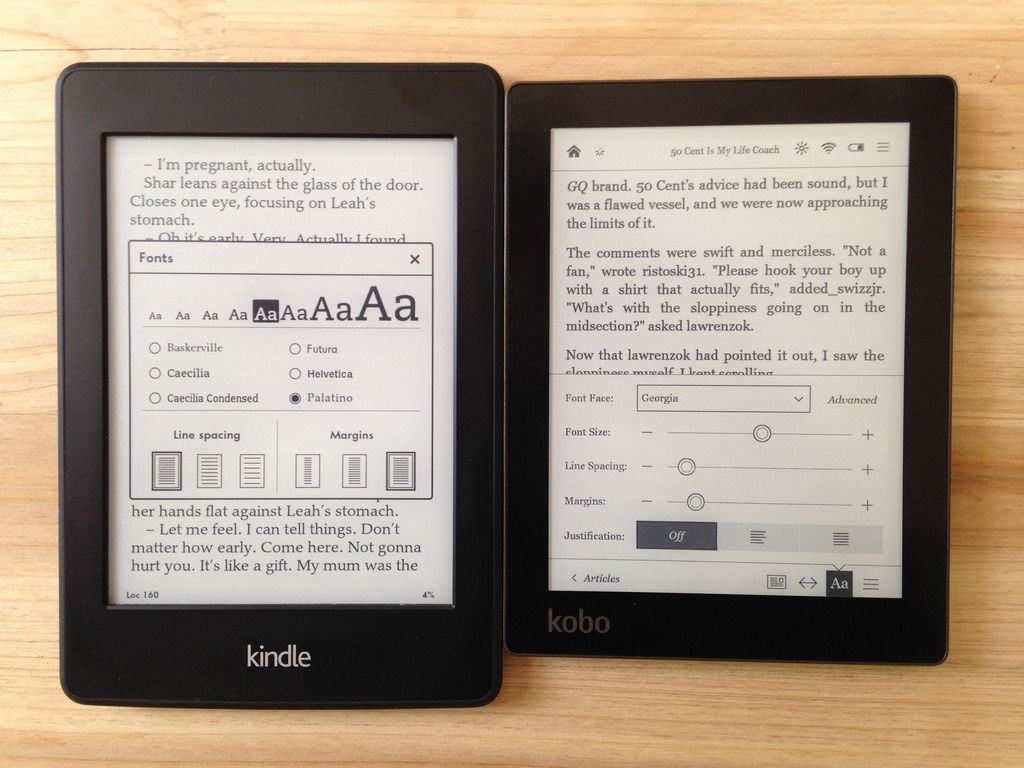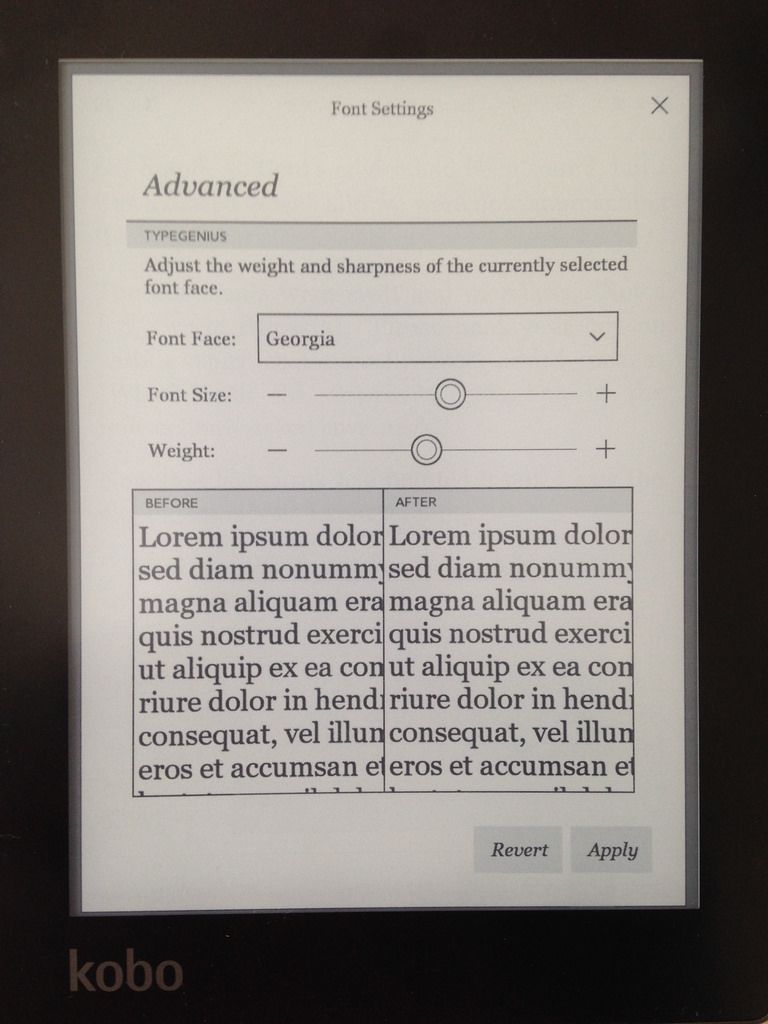I just switched from Kindle to Kobo. Why? Amazon. It’s currently extorting publishing house Hachette by delaying orders and refusing to allow pre-orders for certain titles. The exact machinations are secret, but many people agree that Amazon is demanding discounts on ebooks.
I don’t want to see authors forced to get a second job to survive, so I switched. No more Kindle ebooks. I switched to Kobo, which has a great e-ink reader, a deep book catalog, and – most importantly – breakable DRM.
The results are mixed, with ups and downs for both the service and the hardware.
For a smart author’s view on the Hachette/Amazon spat, read Charlie Stross’ post on the subject. For background, here’s The New York Times’ account. For my take on the hardware and services, keep reading.
I have used Kindles since they were first available outside the U.S. I have owned a 2G version (with 3G), a Kindle Keyboard, and both first- and second-gen Paperwhites. The Paperwhite is amazing, with responsive touch, the best backlit screen yet, and an almost glitch-free OS.
The Kobo Aura is much smaller and lighter than the Paperwhite (174 grams versus 213 grams), but the screen is the same size (6 inches) and resolution (1,024 x 758). Both have backlights, Wi-Fi and batteries that last for (supposedly) two months.
Hardware
The main difference is the screen. The Paperwhite wins in anything but bright sunlight. Its E Ink Carta display is whiter than the Aura’s E Ink ClarityScreen, and the Paperwhite’s light is so much better than the Aura’s that it’s not even funny. Whereas the Kindle’s front light is undetectable – you just see the screen get brighter – the Kobo’s is uneven and looks like a light shining on the screen. There’s even a bright bar up top as the LEDs seem to peek out from under the bezel.
That’s not to say the Kobo’s light is bad – just that the Kindle’s is much better.
Other than this, though, everything about the Kobo hardware is better. It’s just as fast, it has a sliding power button up top (not underneath) and it has a separate switch for the backlight. And speaking of backlights, you can adjust the Kobo’s light by sliding two fingers up and down the screen. No need to access a menu like in the Kindle.
Finally, the Kobo has its screen flush with the bezel like the iPad, instead of raised like a picture frame. This makes it easier to hold, and easier to slip a finger over the screen to flip a page.
Overall, the Kobo Aura is better built than the Kindle Paperwhite, but the screen is less contrasty and has a comparatively poor light. But even this is mitigated by the first of our software features: typography.

Software

The Kindle’s typography is appalling, like a cheap pulp paperback. The Aura, on the other hand, not only offers more fonts but has a layout engine that makes every book you read look great. And this in turn makes reading a lot easier.
You can adjust the margin size, you can choose flush-left, ragged-right text (the Kindle justifies everything, stretching words into unnatural forms), tweak line spacing and choose from 12 fonts, not just six (the Kindle allows adjustments of margins and line spacing too, but it’s not as fine-grained).
What really makes the difference, though, is that the Kobo’s text-rendering engine was made by somebody who cares about typography. The fonts just render better on-screen, and the result is a page that looks like a real book, not just a bunch of letters squashed together into words.
Still not satisfied? You can even fine-tune the weight and size of some fonts in an “advanced” section.
Interface
First, let me tell you that the Kobo can be set to display the cover of your current book as the screensaver when it sleeps. Why the hell doesn’t the Kindle do this? People actually jailbreak their Kindles just to add this feature.
Next up in Kobo’s unstoppable assault is the home page. This shows a lot more than the Kindle’s static list. You get the last book you read, a section for recommendations, another for recently added books, plus spots for the latest Pocket news (more on that in a second). There’s even a tile telling you when the last sync happened, and you can tap it to sync immediately.
This tile-based page makes the Kobo feel a lot more like it belongs to you. The Kindle always felt to me like Amazon owned it. The Kobo is more personal. It even tracks things like your reading activities, kind of like a Fitbit for words (although I don’t use that part).
The friendliness continues with your Library. You can browse just books, or by collection (user-made), or your previews. Previews work in a different way than on the Kindle. Whereas Amazon forces you to choose where to send your samples, Kobo stores them as a part of your library so you can access them from any device or app. This is much better, as anyone who has broken and replaced a Kindle full of samples will know.
Syncing
Speaking of sync, the Kobo is much worse than the Kindle. Purchased books sync their reading positions just fine between the device and your Kindle iOS and Mac apps, but when it comes to personal documents you’re pretty much on your own.
First, the only way to get a book onto your Kobo (other than purchasing) is to plug it into your Mac with a USB cable, and drag the file over using the Finder (or the capable ebook app Calibre. You can’t send documents to the Kobe via email, and you can’t even add them to the desktop app and have them sync to the Kobo Aura device.
Worse still, any books you add to your library stay on that device only, and even if you load the same book onto two different devices (your iPhone and your Aura reader, say) then the reading progress isn’t synced.
The Kindle can do all of these, and is therefore the winner here. By far.
But Kobo brings it back in this stretch because it has a built-in Pocket app. That is, any articles you save to read-later service Pocket are synced to the app on your Kobo. You can browse them as a thumbnail grid or a list, mark them read, delete them and archive them, just like in the regular iOS app, and all this syncs back to your account.
It’s fantastic, and is alone a great reason to switch to Kobo from Kindle. I find myself using it all the time, especially as the tiny Kobo can live in a jeans back pocket without you even noticing, and my Pocket queue has shrunk quite a bit.
DRM and switching
If books were like MP3s, it would be much easier to stop buying ebooks from Amazon and just buy Kobo books for your Kindle. This would, in turn, let the publishers slip out from under Amazon’s lock-in. Ironically, it’s the publishers themselves that still insist on DRM (some, like Tor, sell their Kindle books DRM-free).
Fortunately, I have been ripping my Kindle books this whole time, for just this eventuality. (Read how in the Calibre post, also linked above.) The good news is that the same Apprentice Alf plugin can rip the DRM from Adobe Digital editions, which is the DRM used by Kobo.
In fact, one of my main reasons for switching to Kobo was the fact that I can rip the books and use them anywhere. iBooks’ FairPlay DRM is still mostly uncracked, which is why I never buy iBooks ever.
One note. If you do go the same route as me, you should install the KoboTouchExtended plugin (available from inside Calibre). This converts your regular EPUB files into KEPUBs, which is Kobo’s extended format, and offers some extras like pages remaining in the current chapter and syncing your collections.

Even without that, your Kindle AZW3 files will convert to beautiful EPUB files and work just like Kobo’s own books (only without the sync). Or you could just buy your books from Kobo and rip them onto your Kindle, thus saving the cost of new hardware.
Conclusion
As you’d expect, Amazon’s book catalog and its web-based services beat the Kobo, but hardware- and software-wise the Kobo wins out. I miss being able to find a book in my Dropbox and email straight to my Kindle using just my iPhone, but Kobo’s Pocket integration and the overall user experience more than makes up for that. Even the screen is fine. In sunlight there’s no difference, so the only time I really notice is when I’m reading in bed at night. And by then I’m so sleepy I don’t care.


